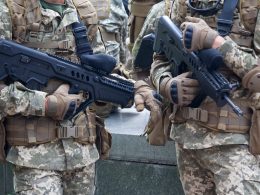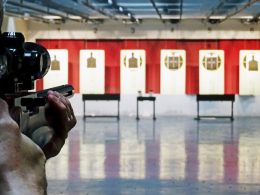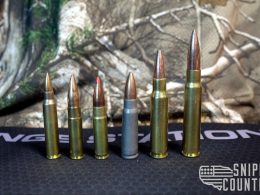
It’s past time for firearms deer season here at home. This year, as in previous years, my son and I will head to the deer blind armed with a .308 and .243 respectively. This is notable because it wasn’t long ago that only pistol cartridges were permitted for deer hunting in my state. While carbines or rifles were allowed, they had to be chambered for pistol cartridges. Now, any caliber .243/6mm or larger is permissible. This change opens up opportunities for a wide variety of cartridges.
But, what defines a rifle cartridge? How is one put together? Why is a .243 bullet the same diameter as one fired from a 6mm rifle? Let’s look at some specifics about cartridge construction and naming conventions, then we’ll look at the specific rounds (a “round” is another word for cartridge).
In this Article:
Naming Conventions
Why is a 6mm cartridge called “6mm” while a .243 cartridge is named “.243”? Both types fire bullets of .243 caliber. Cartridges are typically named based on two main conventions: caliber and metric.
American and British cartridges often adopt names based on their bullet diameter, such as .223, .308, and .243. In contrast, European and other countries often use the metric system, like 5.56×45 (NATO), where 5.56mm refers to the bullet diameter and 45mm to the case length.
Despite these trends, there are exceptions: some American-designed 6mm cartridges use metric designations, while others like the .338 Lapua Magnum (developed by the Finnish company Lapua) use a caliber-based designation.
Cartridge names can also have historical or developmental origins. For instance, the .30-06 denotes a .30-caliber bullet from a cartridge developed in 1906. Such anomalies in naming conventions reflect the diverse history and evolution of ammunition.
A modern centerfire cartridge consists of the following components:
A cartridge case
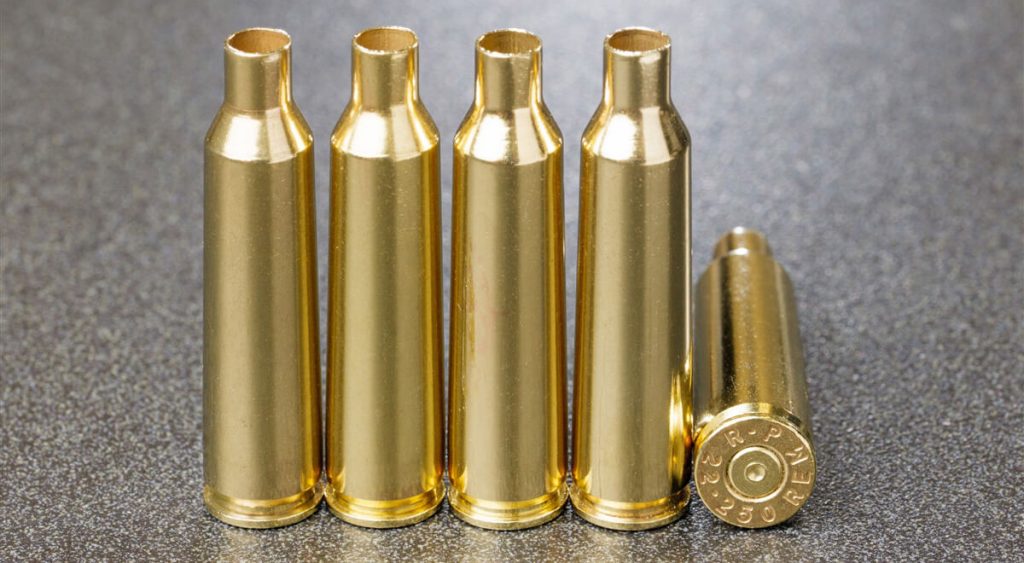
This is the “container”, typically crafted from brass or steel, which houses all the other components of the cartridge. When we mention the “case head,” we’re talking about the bottom part of the case that rests against the breech. This area can feature a rim, which assists with headspace and extraction, or it can be rimless. Before moving forward, it’s important to delve into the concept of headspace. Understanding this concept thoroughly is crucial, particularly if you plan to reload for your rifle.
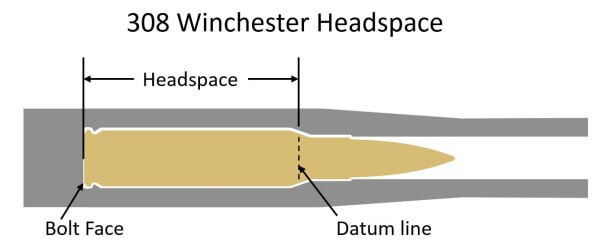
What is “Headspace?“
“Headspace” refers to the specific part of the cartridge case that prevents its forward movement into the chamber, ensuring it remains firmly positioned against the breech. In the case of a rimmed cartridge, headspacing occurs on its extended rim, while a rimless cartridge headspaces on the shoulder of the case. An exception to this is the belted magnum case, which uses a metal band (belt) at its base for headspacing.
Accurate headspacing is critical because if it’s incorrect, the rifle may struggle to chamber or fire the round properly, potentially leading to safety hazards.
Primer
The second component of a cartridge case is the primer. The primer is composed of three main parts:
- The metallic cup that contains the other two components;
- The priming compound that is the catalyst that ignites the powder;
- An “anvil”, or a hard piece of arched metal that the compound is crushed against in order to ignite the powder.
There are two types of primers: Boxer and Berdan..
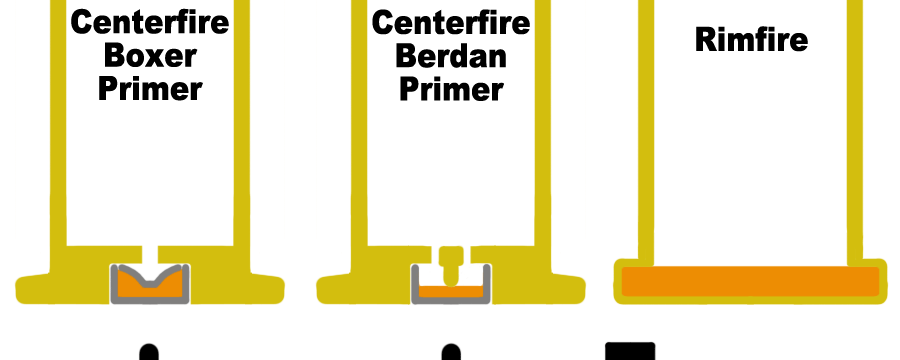
The Boxer primer is totally self-contained, with all three components enclosed within its metal cup. When struck by the firing pin, the priming compound inside the cup is crushed against the rounded anvil, generating the spark that ignites the powder. A single central hole in the bottom of the cartridge case allows the primer to channel through. The Boxer primer is widely favored and predominant in usage.
The Berdan primer is different in two ways: Berdan-primed cases have two tangential (to the center of the case) holes for the spark to travel through and the anvil is not contained in the primer cup but is built into the case as a raised “bump” in the center of the case against which the priming compound is crushed.
Bullet
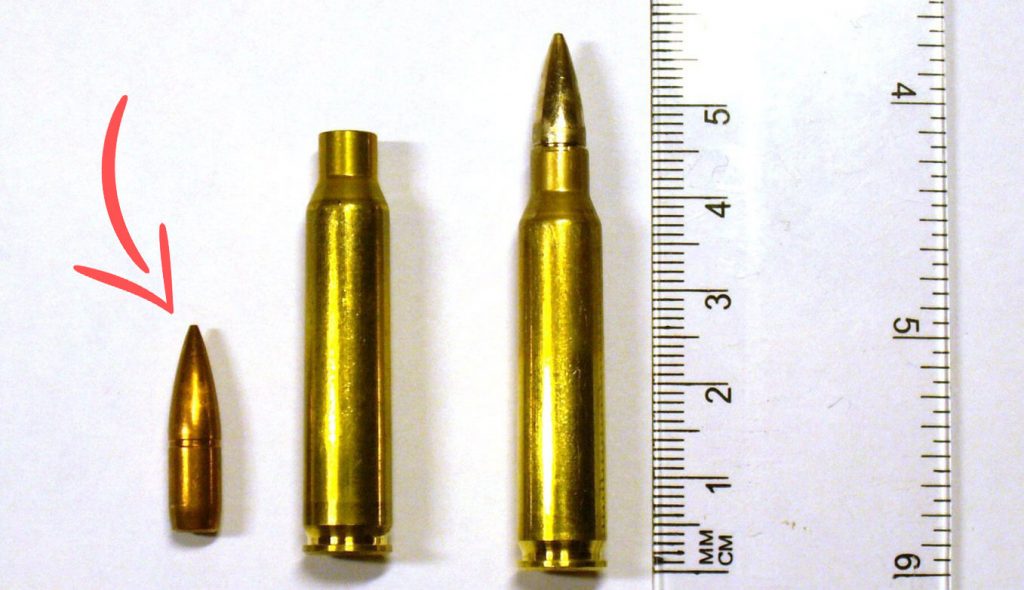
The third component of a cartridge is the bullet. The variety of bullets available in factory ammunition is extensive, making the selection process worthy of its own article. It’s essential to select the appropriate bullet for the intended task. We will delve into bullet weights and styles further when we examine specific cartridges.
Powder
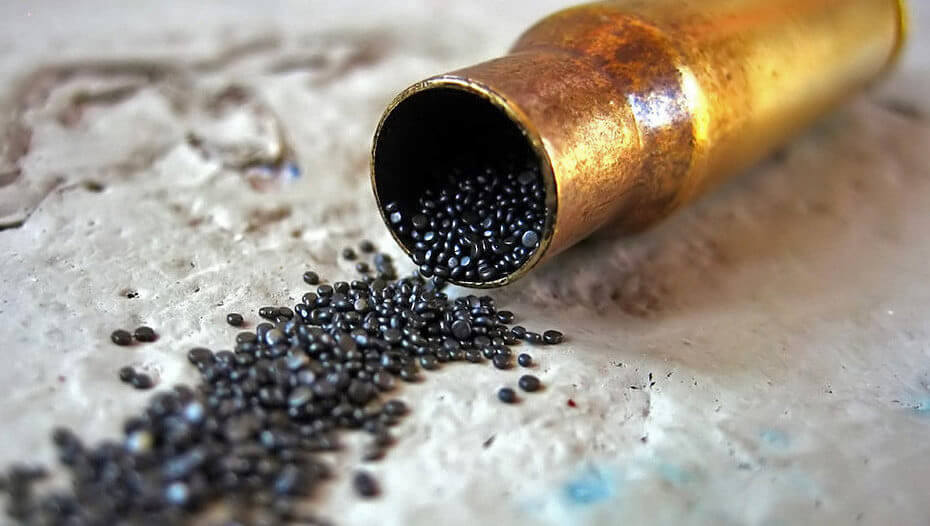
Lastly, the fourth component of a metallic cartridge is the powder. Modern smokeless powders cater to a wide range of specialized tasks. Generally, you’ll opt for a “faster” burn rate powder for non-magnum rounds or those resembling pistol cartridges, and a “slower” powder for magnum rounds or cartridges where maximum velocity is desired. As with bullets, a complete article could be written just about powder.
Now that we understand the construction of a rifle cartridge, let’s examine specific cartridges, roughly in order of their diameter.
A Quick Explanation…
We will look at, among other things, these items:
Rep. Bullet Weight (grains)
Muzzle Velocity (fps)
Muzzle Energy (ft./lbs)
Recoil Energy (ft./lbs.)
Notice that the bullet weight is in grains, the velocity is in feet-per-second and both energy figures are in foot/pounds. If that’s data you are interested in I highly recommend checking out our ammo comparison tool, allowing you to compare more than 300 rounds in 40 different aspects.

Let’s get started…
.22 Long Rifle
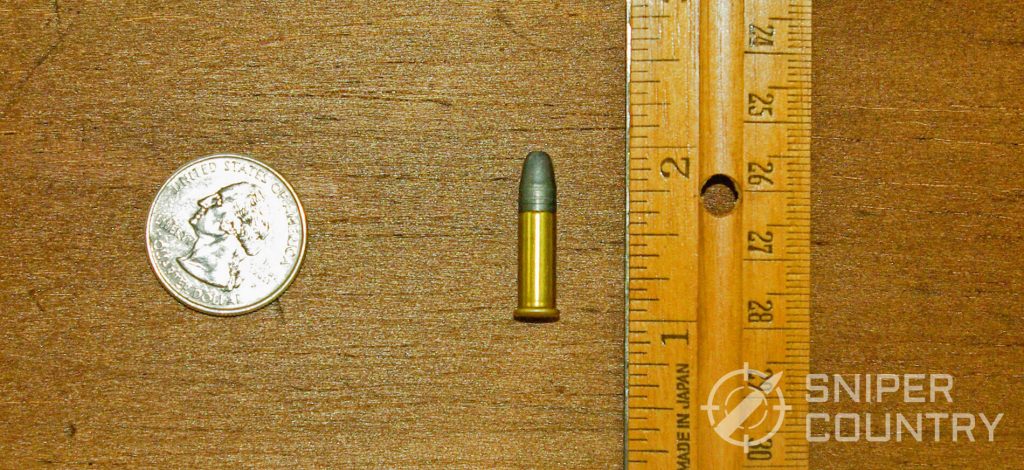
Description: Â The .22 LR is the sole rimfire cartridge on our list. It’s a small-caliber round featuring a heeled bullet design, where the base of the bullet is enclosed within the case, with the bore-riding portion of the bullet exposed. This design is distinct from centerfire cartridges and includes a rimmed case.
History: Introduced in 1887 by Stevens Arms & Tool Co., the .22 LR emerged from combining the 40-grain bullet of the .22 Extra Long with the case of the .22 Long. Since then, it has become the most widely manufactured cartridge. According to estimates by the National Shooting Sports Federation, the .22 LR accounts for approximately half of the 10 billion rounds produced annually.
Applications: target shooting, plinking (informal shooting at improvised targets), training, hunting, entry-level round for those new to shooting. I’m sure there are uses for this popular round that I have not seen – its popularity, availability, low cost, low recoil/noise factor and the plethora of long guns and handguns chambered for it keep it in the top spot where ammo sales are concerned. There are even shotshell variants available.
Typical Rife Type: bolt action, semiautomatic, single shot
Rep. Bullet Weight: 40
Muzzle Velocity: 1120-1140 (standard velocity); 1200-1300 (high velocity); over 1400 (hyper velocity). All number are feet per second.
Muzzle Energy: 115 (standard velocity); 150 (high velocity); 157 (hyper velocity, 36-grain bullet). All number are foot-pounds of energy.
Recoil Energy: 0.2, standard velocity; 0.24, high velocity; 0.23, hyper velocity (36 grain bullet). All numbers are foot-pounds of energy.
Comments: Being the most popular cartridge has numerous advantages. The widespread availability, which experienced a significant shortage around five years ago but has since rebounded strongly, coupled with the vast selection of firearms chambered for it, ensures that the .22 LR will remain the top choice for newcomers entering shooting sports due to its affordability and minimal recoil. Moreover, it continues to reign supreme as the preferred round for small-game hunting in forests and fields. Additionally, many governmental agencies utilize it for training purposes, recognizing its suitability for such tasks. Despite its humble origins, the .22 LR stands out as one of the most versatile and practical rounds available.
.223 Remington / 5.56X45 NATO
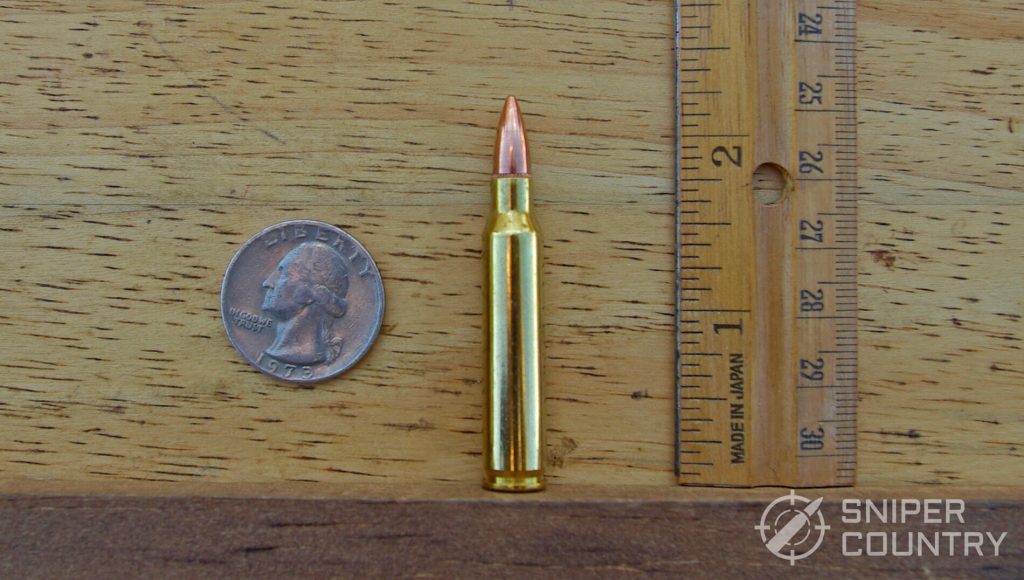
Description: A .22-caliber bottleneck-case cartridge derived from the .222 cartridge, currently serving as the military’s standard small arms and some machine guns round.
History: In 1957, a project began to develop a small-caliber, high-velocity firearm. Eugene Stoner’s scaled-down AR-10 design was chosen for the rifle contract, and the 5.56×45 (.223) round was selected as the cartridge to be used with the rifle. The commercial .223 cartridge was introduced in 1963, followed by the adoption of the military M193 version of the 5.56×45 in the subsequent year.
Applications: Varmint hunting, target, self-defense, military uses
Typical Rife Type: Early rifles were bolt action, with the AR-15 platform following. Probably best known in the AR-15 semiautomatic platform, with thousands of AR-style rifles sold yearly.
Rep. Bullet Weight: 55 grains
Muzzle Velocity: 3240
Muzzle Energy: 1282
Recoil Energy: 3.2
Comments: This round is great in several roles. If you are looking for a way to get into centerfire rifle shooting, this is a good choice. It is also popular in the self-defense/survival role. Little felt recoil, flat trajectory and decent ballistics make this round a best-seller.
.22-250 Remington
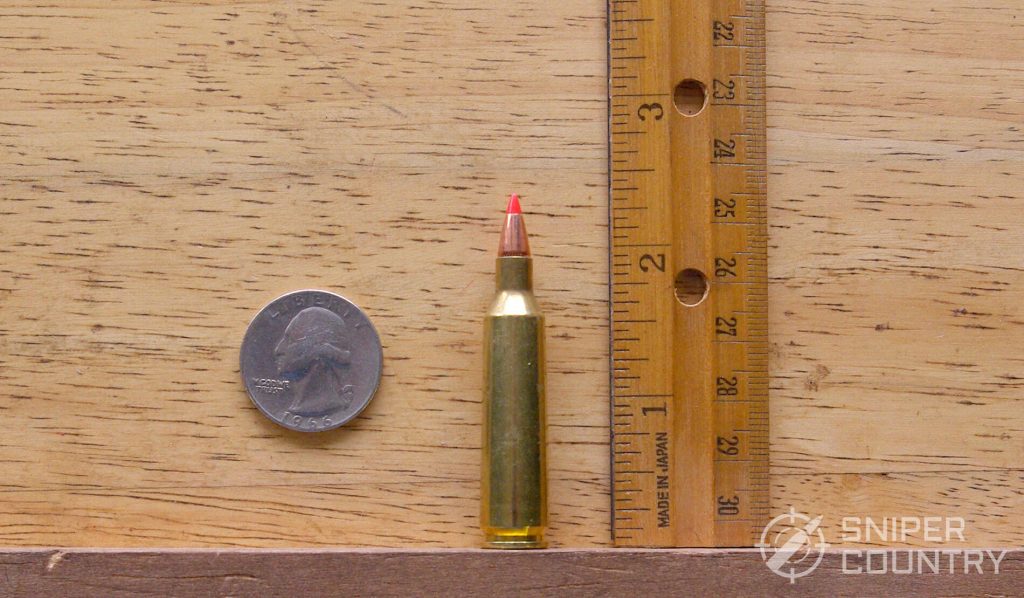
Description: A high-velocity, 224-caliber round designed for varmint hunting
History: The .22-250 started out as a wildcat round. The .250-3000 Savage case was necked down to take .224 bullets around 1937. Its popularity as a wildcat was cemented when Browning introduced their Browning High Power rifle for it in 1963. It was adopted by Remington in 1965 as the .22-250 Remington and added to their lineup. It is still popular, as it is a great varmint round that offers decent barrel life when cared for properly and is easy to reload.
Applications: varmint hunting, medium-sized predators, long-range smallbore shooting and competition
Typical Rife Type: bolt action
Rep. Bullet Weight: 55
Muzzle Velocity: 3680
Muzzle Energy: 1654
Recoil Energy: 8.3
Comments: The .22-250 is considered “king” of American .22-caliber varmint rounds. The .220 Swift technically has greater ballistics but in terms of available ammunition and rifles, stick with the .22-250 if you are looking for a round that will drive a 55-grain bullet to just under 4,000 fps and a 45-grain bullet to over 4,000 fps.
.243 Winchester
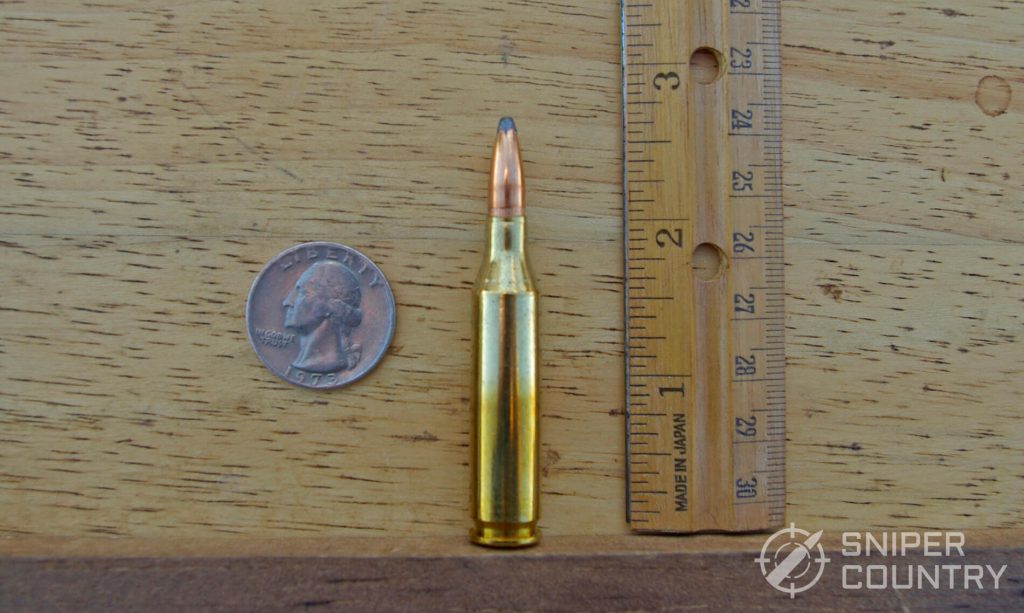
Description: A 6mm/.243 caliber round that is good for varmints or deer-sized game out to 300 yards or so.
History: Introduced in 1955, the .243 was initially designed to perform well with both lighter and heavier bullet weights. Derived from a necked-down .308 case, the .243 has proven its durability over time. Recently, its popularity has seen a resurgence as more states have designated the .243/6mm as suitable for deer hunting, expanding its appeal among hunters.
Applications: hunting both varmints and deer, long-range competition, target shooting
Typical Rife Type: bolt action
Rep. Bullet Weight: 95
Muzzle Velocity: 3100
Muzzle Energy: 2027
Recoil Energy: 11.3
Comments: I own a .243 Savage Axis II rifle and have successfully harvested deer with it. This cartridge showcases remarkable versatility—using heavier bullets for deer hunting and lighter ones for varmint control at distances exceeding 400 yards. It’s one of the most economical and versatile sub-.30-caliber rifles available. While its popularity has somewhat waned with the emergence of Creedmoor cartridges (discussed below), the .243 remains a strong seller with abundant ammunition options readily accessible.
6mm Creedmoor
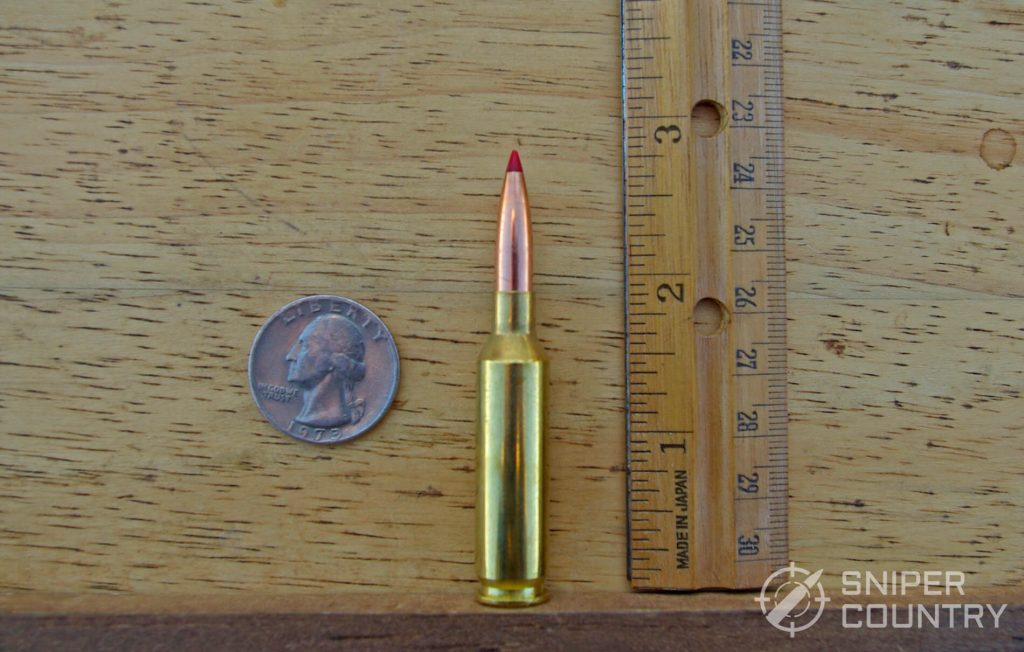
Description: A necked-down 6.5 Creedmoor case is the basis for a cartridge that fires a .264-inch bullet. The 6.5 Creedmoor excels at long-range competitive shooting and hunting.
History: The 6mm Creedmoor was originally designed with a focus on long-range target shooting but has also become highly regarded as a hunting round. Its popularity stems from the excellent ballistic coefficients and sectional densities associated with .264 caliber bullets, making it a versatile and effective choice for various shooting disciplines.
Applications: long range shooting; hunting
Typical Rife Type: bolt action
Rep. Bullet Weight: 103
Muzzle Velocity: 3050
Muzzle Energy: 2127
Recoil Energy: 12.5
Comments: If you are into shooting at 500-yards-plus or are looking for a great deer rifle out to 400 yards or so, the 6mm Creedmoor is worth a look. Easy to reload, it’s a winner.
6.5 Creedmoor
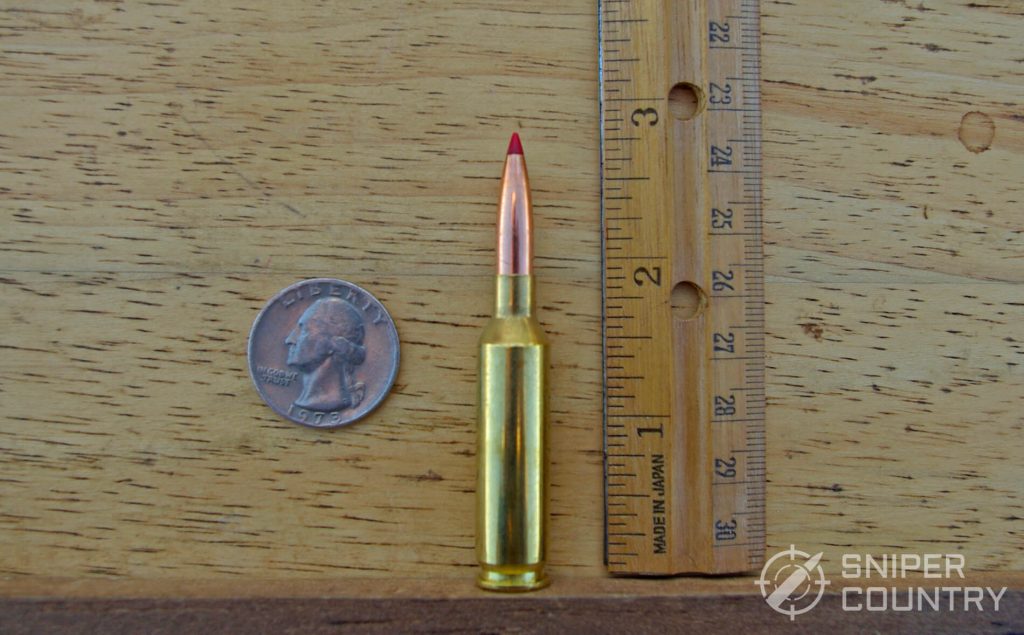
Description: Long range mid-caliber hunting and competition round.
History: The 6.5 Creedmoor was introduced by Hornady in 2007 and utilizes the .30 T/C case as its foundation. Designed to deliver less recoil compared to a .308 while still achieving sufficient velocity for exceptional ballistic performance, this cartridge has consistently been recognized as one of the top choices for long-range competition shooting since its inception. It is renowned for its accuracy at distances of 1000 yards or more.
Applications: extreme long range competitions; hunting
Typical Rife Type: bolt action
Rep. Bullet Weight: 120
Muzzle Velocity: 3020
Muzzle Energy: 2430
Recoil Energy: 15.7
Comments: For those seeking an extreme long-range competition cartridge or a hunting round more powerful than a .243 but with less recoil than a .308, the 6.5 Creedmoor fits the bill perfectly. This versatile cartridge has been utilized globally for hunting various game types and has a strong record of success in long-range competitions.
.270 Winchester
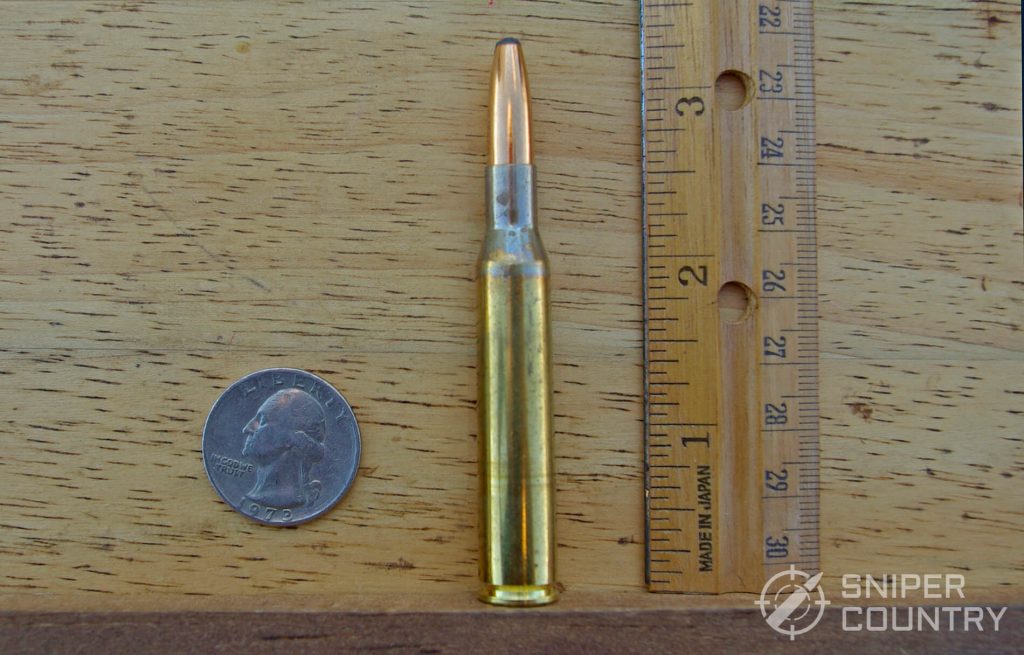
Description: An old reliable. The .270 has been around for over 90 years but still delivers, with bullets weighing from 90 – 150 grains.
History: Introduced in 1925, the .270 gained substantial recognition during the 1940s and 1950s, largely due to influential writers like Jack O’Connor and Townsend Whelen who extolled its virtues. Its popularity remains robust to this day, with continued strong demand among shooters and hunters alike.
Applications: Hunting deer- or antelope-sized game or varmints with lighter bullets
Typical Rife Type: bolt action
Rep. Bullet Weight: 130
Muzzle Velocity: 3060
Muzzle Energy: 2595
Recoil Energy: 17.3
Comments: Since its introduction in 1925, the .270 has been effectively used to hunt game animals ranging from coyotes to antelope-sized and even larger species. With plentiful reloading supplies and a wide array of factory loads available, this versatile cartridge is expected to remain popular for many years to come.
7mm-08 Remington
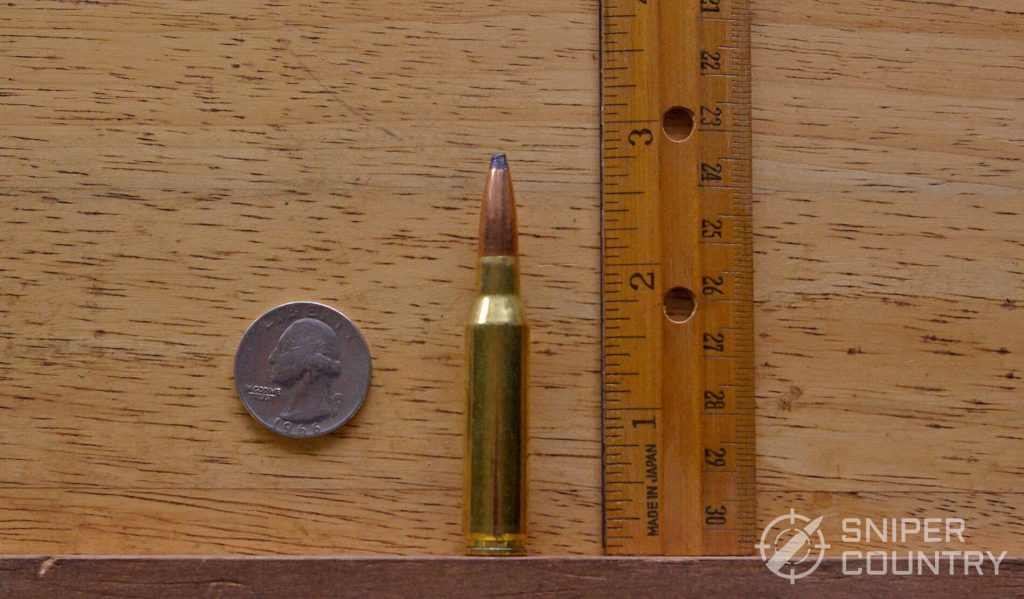
Description: A .284-caliber rifle round that is equally at home ringing metal targets or taking game from deer to non-dangerous plains animals.
History: The 7mm-08 Remington is derived from a necked-down and slightly lengthened .308 case, initially known as the wildcat 7mm/308. Remington officially recognized its potential in 1980 by introducing two rifles chambered for this cartridge. It has gained popularity among gunwriters and enthusiasts alike for its versatility, flat trajectory, and manageable recoil characteristics.
Applications: Hunting deer-sized game and larger, non-dangerous plains animals; metallic silhouette and long range shooting
Typical Rife Type: bolt action
Rep. Bullet Weight: 140
Muzzle Velocity: 2800
Muzzle Energy: 2437
Recoil Energy: 16.7
Comments: For those seeking a cartridge capable of handling windy conditions with substantial knockdown power, the 7mm-08 Remington is worth considering. Whether you’re engaging metal targets at 500 yards or hunting thin-skinned African game, this versatile cartridge excels across a variety of scenarios.
7mm Remington Magnum
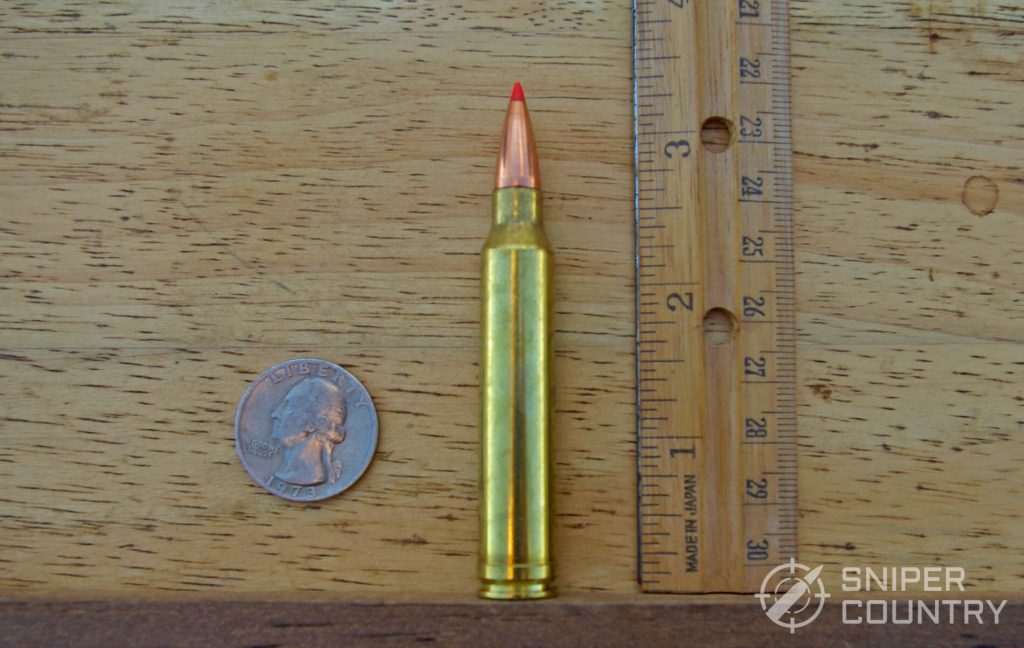
Description: A belted magnum cartridge for big game animals.
History: With its introduction in 1962, the 7mm Rem. Magnum has stayed popular among those who hunt large animals. Its belted case is derived from the famous .375 H&H Magnum; it headspaces on the belt, as do most belted cartridges.
Applications: hunting, sniping, long-distance shooting
Typical Rife Type: bolt action
Rep. Bullet Weight: 154
Muzzle Velocity: 3100
Muzzle Energy: 3286
Recoil Energy: 26.2
Comments: The 7mm Remington Magnum’s versatility is underscored by its adoption for use by the U.S. Secret Service Counter-Sniper Team and its widespread application in hunting large game both in the United States and Africa. Known for its flat trajectory and manageable recoil, this cartridge is highly regarded as a great all-around choice for various shooting disciplines and hunting scenarios.
.300 BLK (.300 AAC Blackout)
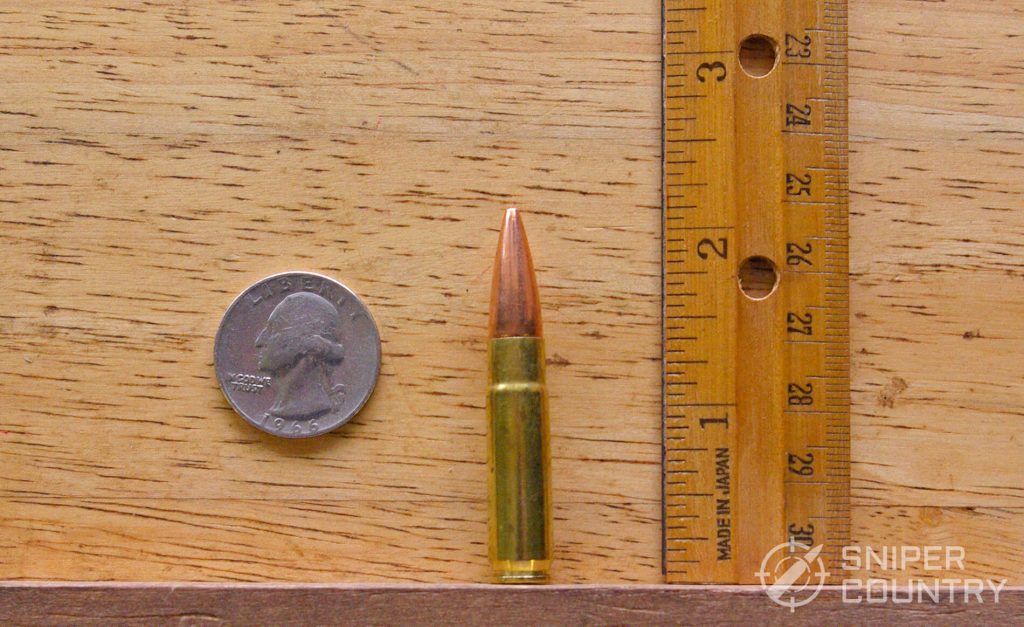
Description: A short, .30-caliber round designed to imitate the ballistics of the 7.62×39 in an AR-platform rifle.
History: Certain military special units sought a cartridge with greater knockdown power than the 5.56 NATO round provided. They collaborated with Advanced Armament Corporation (AAC), which subsequently developed the .300 Blackout (BLK). This cartridge replicates the ballistics of the 7.62x39mm round in a subsonic platform, meeting the demands for enhanced performance in specialized military applications.
Applications: military, hunting, short-range metallic or other competitions
Typical Rife Type: semiauto (AR)
Rep. Bullet Weight: 125
Muzzle Velocity: 2215
Muzzle Energy: 1360
Recoil Energy: 6.6
Comments: The .300 Blackout performs exceptionally well in suppressed ARs due to its subsonic nature. It required some experimentation to optimize the AR platform for this low-pressure round, but it has since become widely popular. Hunters pursuing medium-sized game, including deer, favor it for its semi-automatic capability and the availability of multiple rounds. It has gained particular popularity among hog hunters for its effectiveness in controlling feral hog populations.
.300 Winchester Short Magnum
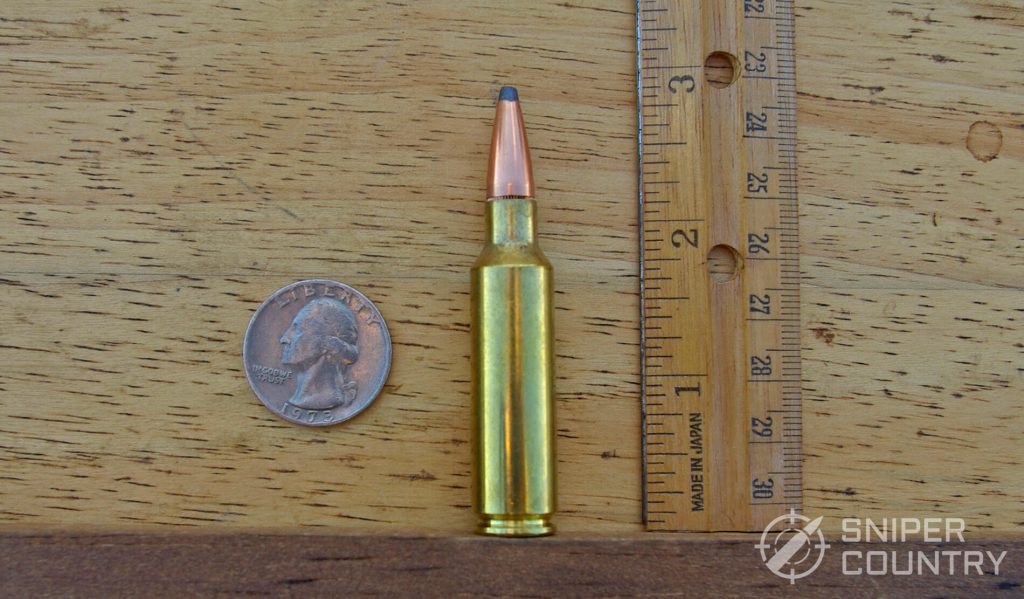
Description: A rebated rim, short magnum-cased .308-caliber cartridge with a case length of only 2.10 inch.
History: This round was developed in the early 2000s by the Winchester company with the aim of replicating the ballistics of the .300 Winchester Magnum in a shorter and lighter rifle platform.
Applications: hunting large game
Typical Rife Type: bolt action
Rep. Bullet Weight: 165
Muzzle Velocity: 3223
Muzzle Energy: 3807
Recoil Energy: 28.3
Comments: This round is part of the family of short magnums produced by Winchester and other manufacturers. If you’re interested in achieving magnum-level ballistics with a shorter, lighter, and more easily carried rifle, it’s definitely worth considering.
.300 Winchester Magnum
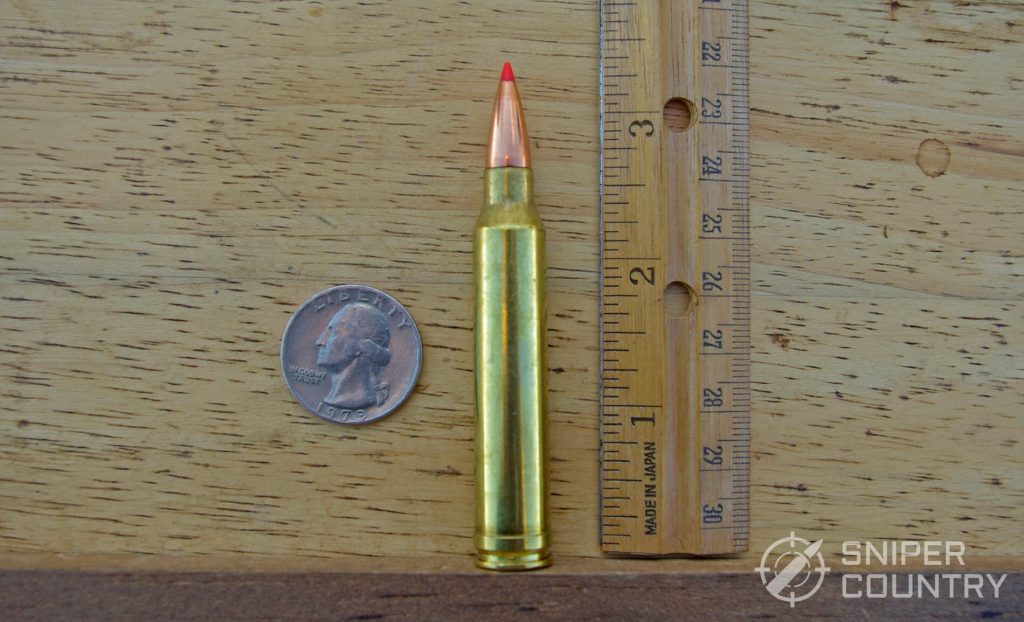
Description: A belted, bottleneck magnum rifle cartridge designed to fit in a standard rifle action.
History: This round, introduced by Winchester in 1963 for its Model 70 rifle, shares the same case head dimensions as its parent cartridge, the .375 H&H Magnum. Despite the introduction of other .30-caliber magnums around the same time, this cartridge has remained popular while others have faded away.
Applications: hunting large game
Typical Rife Type: bolt action
Rep. Bullet Weight: 180
Muzzle Velocity: 3146
Muzzle Energy: 3972
Recoil Energy: 33.9
Comments: If you are looking for a major player in the .30-caliber-magnum wars, take a look at the .300 Win Mag. With muzzle energy of almost two tons, there are few game animals around that this rifle couldn’t handle.
.30-30 Winchester
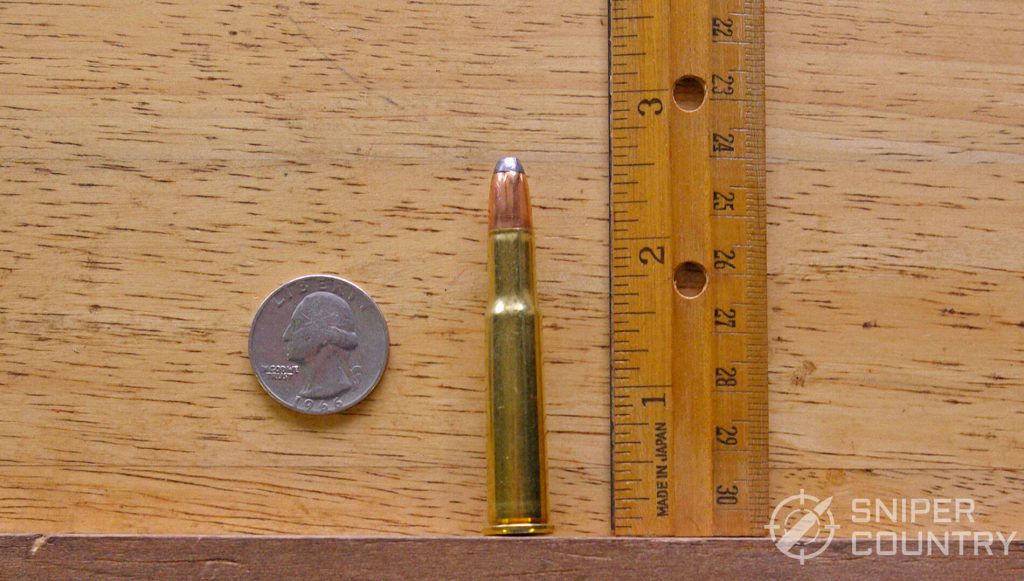
Description: A medium-level .30-caliber round that uses a rimmed cartridge and is usually found in lever action rifles.
History: Derived from the old black powder .30 Smokeless round introduced in 1898, the .30-30 was renamed to denote both its caliber and the transition to smokeless powder. Its enduring popularity stems from its association with lever-action rifles, which were predominant among hunters during its early years and remain widely available at affordable prices.
Applications: hunting medium- to big-game (North America); probably the most popular deer rifle cartridge in use today.
Typical Rife Type: lever action
Rep. Bullet Weight: 150
Muzzle Velocity: 2390
Muzzle Energy: 1903
Recoil Energy: 11.2
Comments: With its light recoil, .30-caliber expanding bullet, and affordable lightweight lever-action rifles, the .30-30 stands as the most popular deer round available for that action type. It’s widely regarded as the entry-level caliber for big game hunting, offering effective performance on deer-sized game out to distances of approximately 200 yards.
.30-06 Springfield
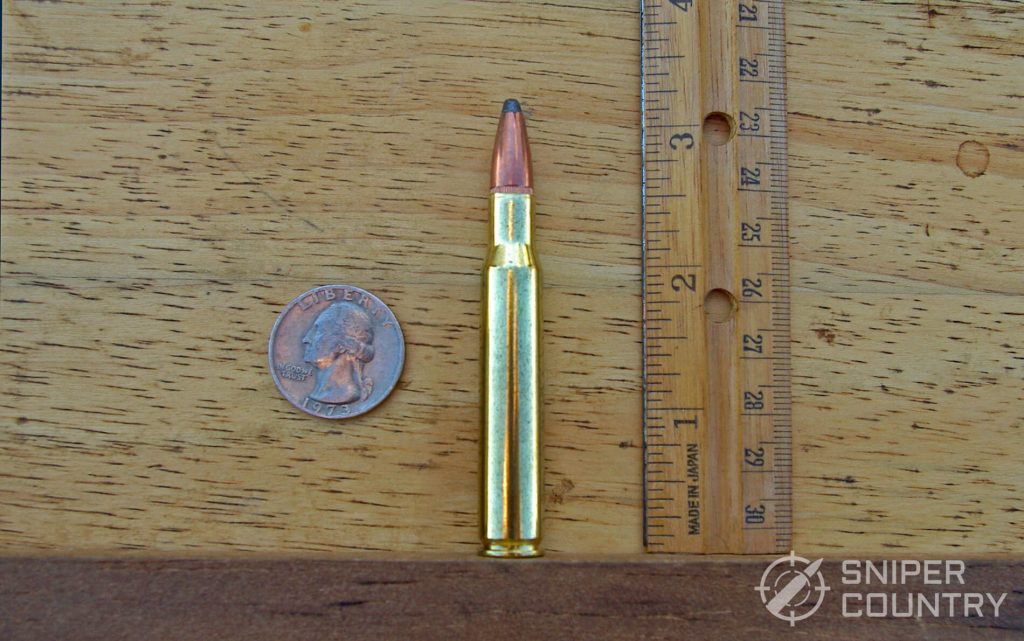
Description: According to articles from the N.R.A. and Outdoor Life, the .30-06 is considered the most popular all-around hunting round in the U.S. This .30-caliber cartridge has demonstrated its effectiveness both in wartime and in hunting scenarios. It features a rimless, bottlenecked design with a maximum case length of 2.94 inches.
History: The .30-06 round was introduced as the new military rifle cartridge in 1906. Named for its .30-caliber bullet and the year of its adoption, the designation ” .30-06″ has endured to the present day. Initially chambered in the 1903 Springfield bolt-action rifle, it gained renown as the primary cartridge for the M1 Garand rifle, as well as the 1919 air-cooled machine gun and other firearms. Today, it is highly esteemed as a versatile hunting round capable of taking most game animals found in the United States.
Applications: military (service round until the 7.62×51 .308 replaced it in 1954), hunting, target shooting, long-range competition
Typical Rife Type: bolt action
Rep. Bullet Weight: 150
Muzzle Velocity: 2910
Muzzle Energy: 2820
Recoil Energy: 16
Comments: Despite its retirement from military service, civilian shooters continue to favor rifles chambered in .30-06. Known for its robust recoil, which approaches the upper limits of what most shooters find comfortable, it remains a popular choice among enthusiasts. Whether you’re a competitive paper target shooter, military match competitor, hunter, or firearms enthusiast of any kind, the .30-06 persists due to its versatility. It offers a wide range of bullet weights and is known for being easy to reload, making it adaptable to various shooting disciplines and preferences.
.308 / 7.62X51 NATO
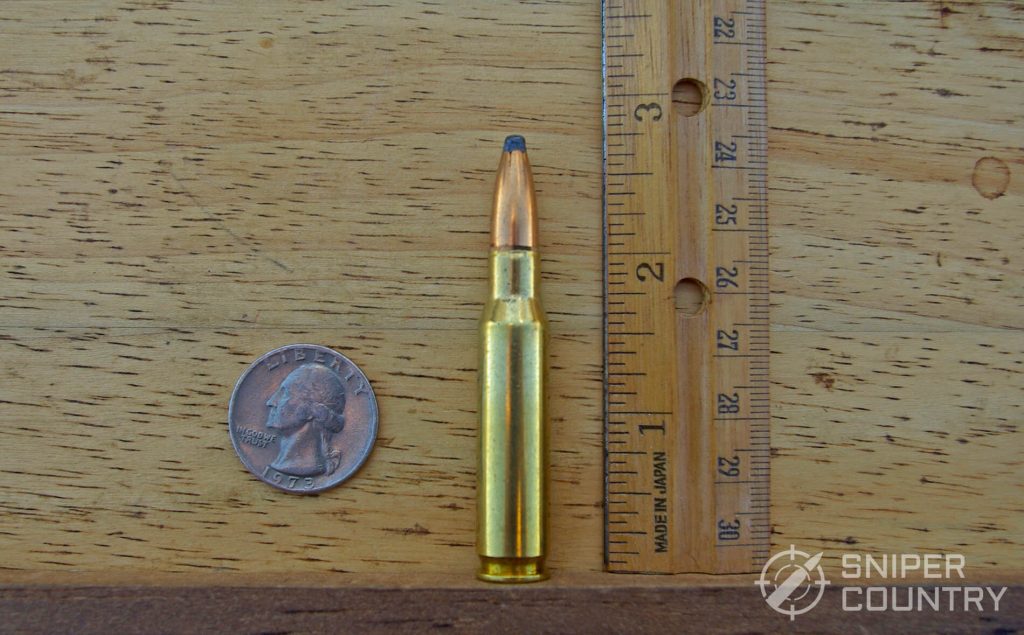
Description: A rimless, bottlenecked cartridge that shoots a .308-caliber bullet.
History: The .308 round made its civilian debut in 1952, followed by its military adoption two years later. It has since emerged as the most popular short-action big game hunting round globally. The case of the .308 is 0.92 inches shorter than that of the .30-06.
Applications: hunting, military, law enforcement (sniping), target shooting, bench rest matches, other shooting sports.
Typical Rife Type: bolt action
Rep. Bullet Weight: 150
Muzzle Velocity: 2820
Muzzle Energy: 2648
Recoil Energy: 14.4
Comments: The .308 stands out as a .30-caliber round capable of challenging the .30-06 for dominance among non-magnum 30-calibers. Its shorter case length allows it to fit into lighter and more compact rifles, while its impressive terminal ballistics make it incredibly versatile. Whether using light bullets for varmints or heavier ones for medium- to big-game, the .308 delivers effective performance across a wide range of applications. Its popularity is further bolstered by its widespread use in law enforcement and military roles, solidifying its status as a highly sought-after cartridge.
7.62.X39mm

Description: A short-cased, mid-level .30-caliber round used mostly in semiauto rifles for self-defense or hunting
History: In 1943, Russia developed a new intermediate cartridge, the 7.62x39mm, designed to be used in rifles, carbines, and automatic/selective-fire weapons. The cartridge quickly gained popularity due to its effectiveness and reliability in harsh conditions. Following the war, the AK-47 rifle was chambered for this round, further enhancing its reputation. Today, the 7.62x39mm cartridge is available in semi-automatic or bolt-action rifles and is legal for deer hunting in many states when using appropriate ammunition.
Applications: informal shooting, short-to-medium range hunting, self-defense
Typical Rife Type: semiauto (i.e., SKS/AK47)
Rep. Bullet Weight: 123
Muzzle Velocity: 2309
Muzzle Energy: 1547
Recoil Energy: 8.1
Comments: If you’re seeking an affordable rifle with abundant steel-cased military-surplus ammunition, the 7.62x39mm round is an ideal choice. When paired with suitable ammunition, it functions effectively as a deer rifle in wooded environments at closer ranges. Its low recoil and the reliable performance of rifles and carbines chambered for this round further enhance its appeal.
.338 Lapua Magnum
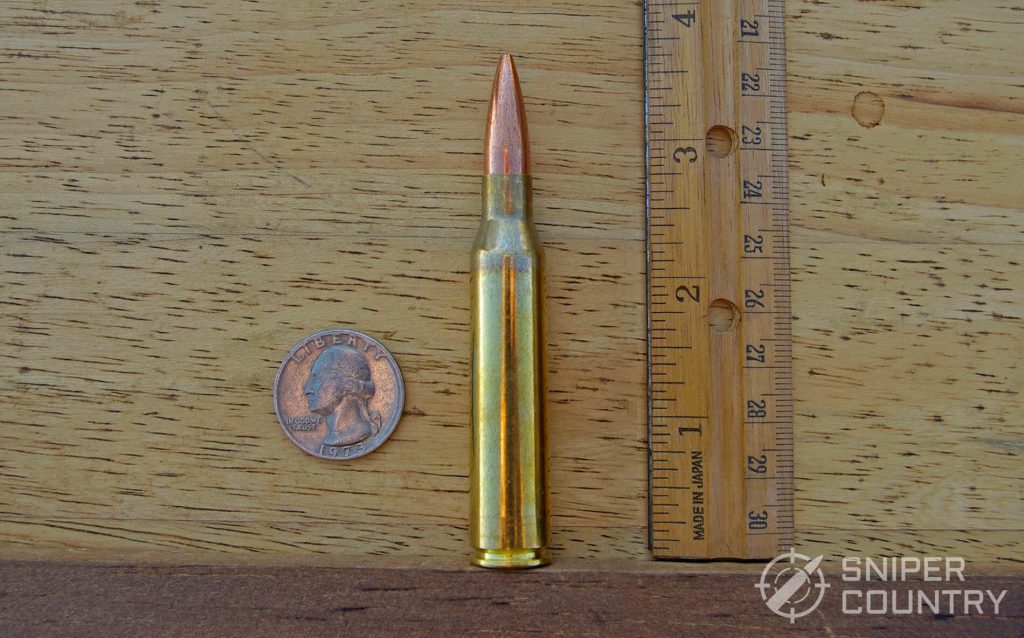
Description: A heavy-caliber, high-energy .338 round designed for military sniping.
History: The .338 round was initially developed in the 1980s as a long-range sniper cartridge for use in Afghanistan and Iraq. A specialized British variant of the .338 was employed to achieve the longest confirmed sniper kill record in 2009, with a verified hit at 2,707 yards. Today, this round continues to be utilized as a hunting cartridge for various types of game due to its effective long-range capabilities.
Applications: military (sniping); hunting; long-distance shooting
Typical Rife Type: bolt action
Rep. Bullet Weight: 250
Muzzle Velocity: 3000
Muzzle Energy: 4893
Recoil Energy: 43.1
Comments: The .338 Lapua Magnum is the king of sniping rounds (well, if you don’t count the .50 BMG). Its enormous muzzle energy, close to 2 ½ tons in ft/lbs., helps get the bullet downrange with a flat trajectory and ensures that whatever it hits goes down. Capable of penetrating body armor at 1,000 meters, the round’s hunting applications are numerous. It would be just the thing for thick-skinned African game (although if hunting elephant, rhinoceros or other dangerous game a back-up rifle of larger caliber is suggested), If you are able to afford to feed it ($2.30 – $3.00 per round), it makes one great rifle to shoot, hunt with or otherwise really impress your shooting buddies! Interesting notes: “Lapua” comes from the Finnish ammunition company that helped develop it. Also, the round is being groomed to replace the .300 Winchester Magnum and the .50 BMG rounds in their anti-personnel sniping roles.
.458 SOCOM
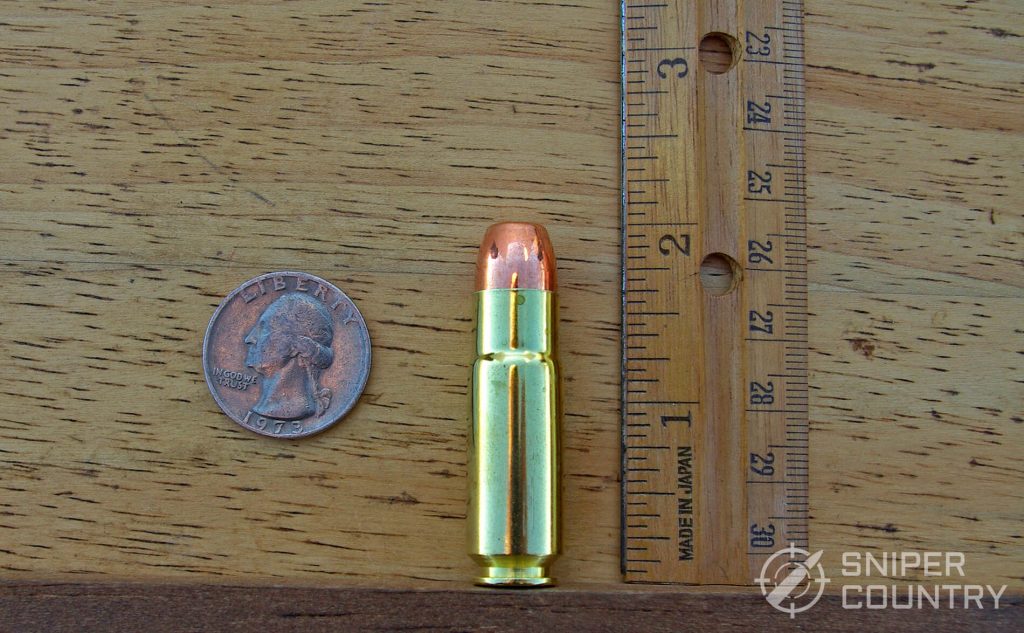
Description: Large-caliber, heavy-bullet load designed to improve stopping power over the 5.56 round when fired from an AR-pattern rifle
History: Introduced officially in 2001, the round was developed following discussions among Special Operations Command (SOCOM) forces who identified a need for a new cartridge after experiencing challenges with multiple shots required to stop opponents in Mogadishu. The case of this round was based on the .50 Action Express (AE), but it was lengthened and the rim trimmed to .473 inches. This modification enables it to be fired in AR-15/M16 platforms, enhancing its versatility and suitability for military applications.
Applications: Hunting, self defense,military, alternate caliber for an AR-15 lower
Typical Rife Type: semiauto (AR)
Rep. Bullet Weight: 300
Muzzle Velocity: 1900
Muzzle Energy: 2405
Recoil Energy: 30.5
Comments: The .458 SOCOM round is engineered to feed from standard G.I. magazines, where a 20-round magazine can hold 7 rounds of .458 SOCOM without requiring any modifications. Along with the .50 Beowulf, it performs effectively at close to medium ranges against various targets. When paired with the appropriate upper in this caliber, it is fully compatible with the M4 carbine platform. This cartridge excels at medium to large game hunting within approximately 150 yards and provides robust protection in bear country.
.50 Beowulf
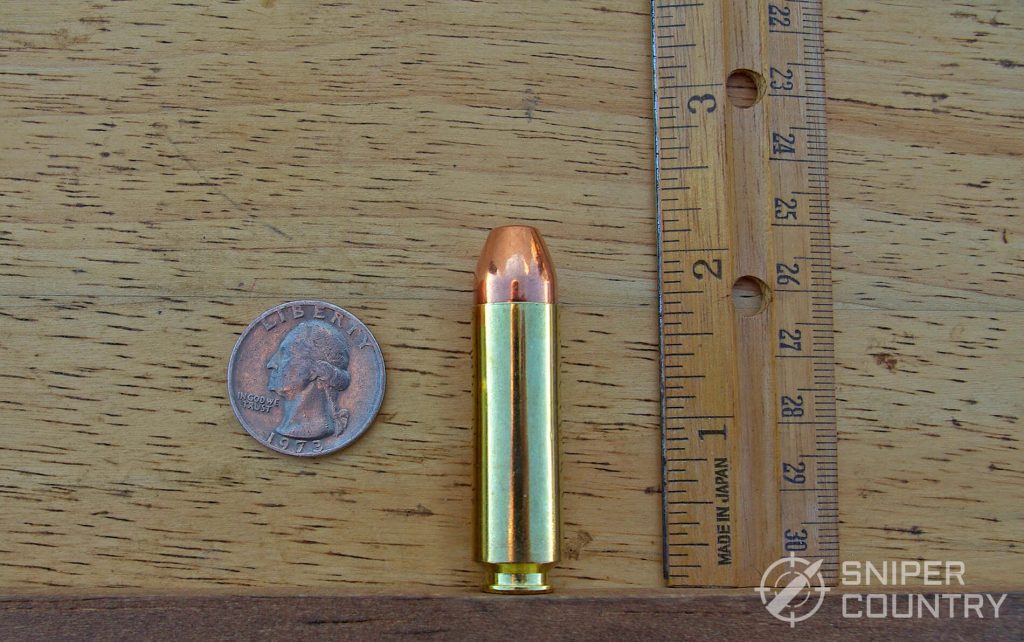
Description: A heavy-bullet, .500-caliber bullet/cartridge designed to improve stopping power over the 5.56 round when fired from an AR-15.
History: Introduced by Alexander Arms, the .50 Beowulf round was designed around a rebated-rim case that accommodates a 7.62×39 bolt face. Alexander Arms adapted its tapered case from a .50 Action Express (AE) cartridge to ensure functionality in semiautomatic rifles. Detailed information about this round beyond its design and compatibility is limited.
Applications: Stopping vehicles that attempt to go through checkpoints, hunting all North American game, other defensive applications
Typical Rife Type: semiauto (AR)
Rep. Bullet Weight: 400
Muzzle Velocity: 1875
Muzzle Energy: 3123
Recoil Energy: 43.1
Comments: If you’re seeking a major-league critter thumper based on the AR-15 platform, the .50 Beowulf fits the bill. With a 400-grain, .50-caliber bullet delivering over a ton and a half of muzzle energy, it’s capable of taking down any animal on the continent within reasonable range. However, due to its heavy bullets fired at velocities akin to .45-70, it exhibits a rainbow-like trajectory beyond about 150 yards. Its standout feature is the ability to fire such massive bullets from an AR-15, ensuring multiple follow-up shots if needed.
Conclusions
No matter what your rifle needs are, there’s a cartridge listed here that can fulfill them. From 55-grain varmint rounds to powerful magnums, you have a wide range of options. While some of these rounds may be costly, if you find one that suits your shooting style and needs, reloading can be a cost-effective solution. While factory ammo is convenient, it can become expensive over time.
Let’s look at some specific recommendations…
For deer hunting, any caliber above .22 is suitable. (Apologies to those in states where .22 caliber is legal for deer hunting; it’s not permitted where I reside). Magnum rounds are typically unnecessary for deer-sized game and may be overkill. In my area, popular deer hunting calibers include .243/6mm, .30-30, .308, and .30-06. I’m sure every deer hunter has their preferred choice.
Varmints (small game like coyotes or smaller) are effectively dispatched with the .22 caliber rifles discussed earlier (and some larger calibers). To ensure small varmints are effectively neutralized (unless you want to preserve the hide or pelt intact), light and fast bullets that fragment upon impact are recommended. Since varmint hunting often involves longer ranges, quality optics are essential for accurate targeting at extended distances.
Paper Target (Bullseye/Military Rifle) Competition – The dominant choice in long-standing bullseye competitions continues to be the venerable .30-06 caliber. When shooting with open sights, such as on a military-surplus M1 Garand, shooters face the challenge of performing consistently at distances of 100 yards and beyond. While some competitors opt for rifles chambered in .308 or other calibers, the decision ultimately rests on personal preference and what each shooter feels most comfortable and proficient with.
Metallic Silhouette Competition – Similar to the deer calibers discussed earlier, any caliber larger than .22 should generally be effective, particularly at longer distances. However, some shooting ranges impose restrictions on allowed calibers to prevent damage to steel targets, which can occur with rifles capable of piercing them. For extreme long-range metallic target shooting, shooters typically use calibers akin to the .338 Lapua Magnum, designed for engaging steel targets situated at significant distances. there. Again, target damage can be a concern so each match has the right to dictate which calibers are allowed.
Self-Defense – In this context, there’s a wide range of suitable calibers for self-defense purposes. The .223 and .308 are particularly popular choices. When selecting a rifle for home or vehicle defense, one critical consideration is the risk of overpenetration. In a life-threatening situation, the goal is to effectively stop threats without risking harm to innocent bystanders due to bullets passing through walls or barriers. Many people opt for firearms chambered in .223 or 7.62×39 for these roles because these rounds generally strike a balance of stopping power and reduced risk of overpenetration, particularly when compared to larger caliber rounds.
We have looked at a few popular rifle calibers and have examined some possible usage scenarios. The final thought that I want to leave you with is that everything written above is based or colored by my experiences. You may see other calibers as viable and might be asking “why wasn’t ___ included?”. As stated, this article is based on personal experiences and is written through my perspective. There are many fine rifle calibers out there – you may have others that you shoot regularly that fill a need for you. That’s great – I had to choose just a few to write about. If you have a favorite I didn’t mention or if you’ve had a really cool hunting or other type of adventure with your rifle(s), leave a comment below. Now…get out there, be safe, and go shooting!

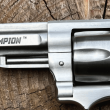
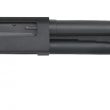
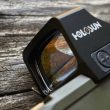
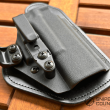
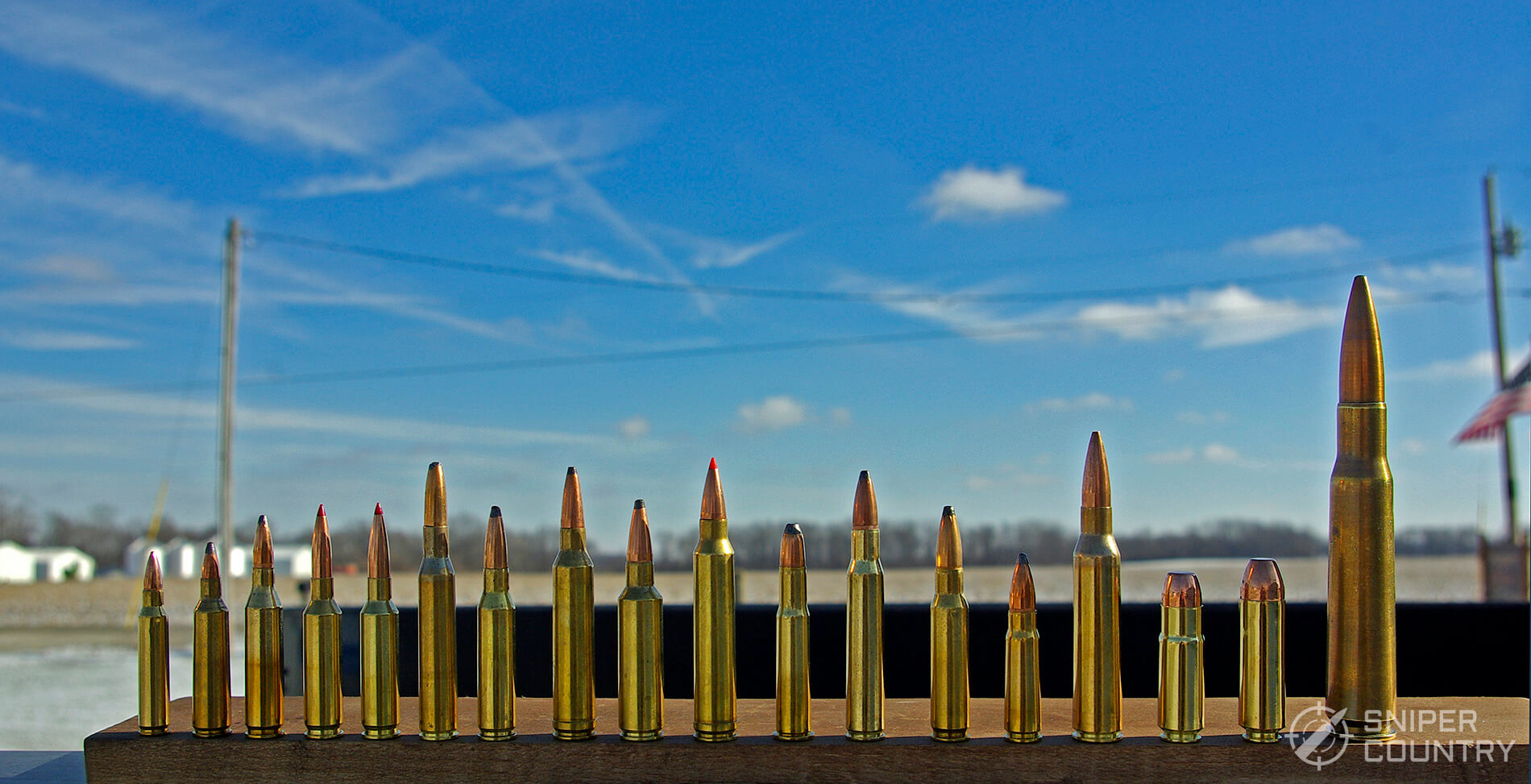
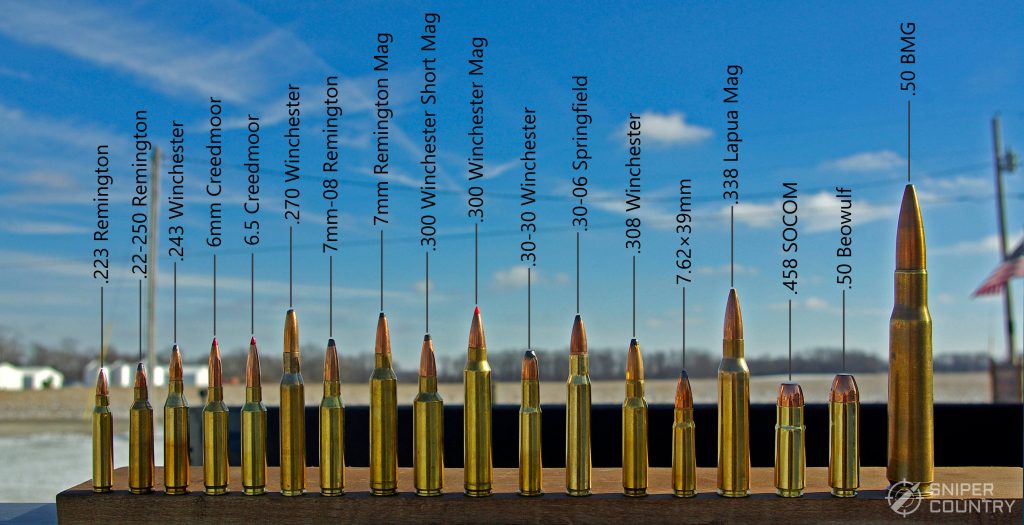
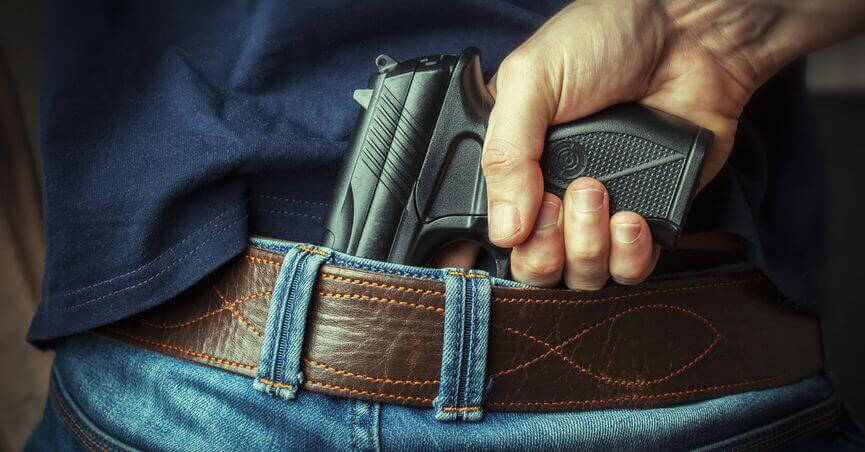
![Best Browning 1911-380 Holsters [2018]](http://161.35.252.213/wp-content/uploads/2018/06/Best-Browning-1911-380-Holsters-2018-260x195.jpg)
